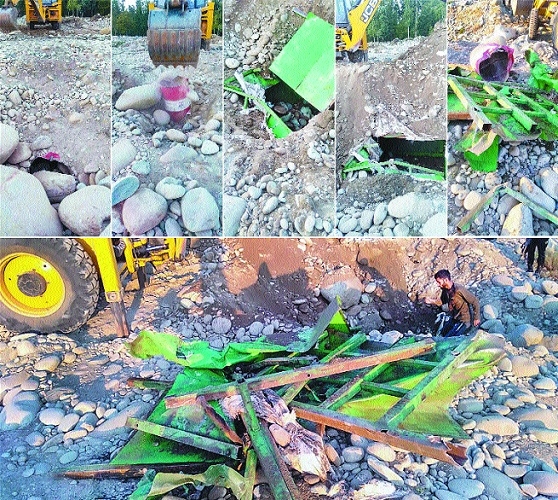Terrorists dig bunkers in orchards, stream to escape Army in Valley
| Date :21-Sep-2020 |

Underground bunker in Shopian unearthed by the Army. (PTI)
By Sumir Kaul :
SHOPIAN,
HIDEOUTS in higher reaches and seeking refuge in local houses are a thing of the past as terrorists in Kashmir Valley now dig underground bunkers in dense orchards and even in seasonal streams to escape the dragnet of Army and security forces. “This trend has been witnessed off late in twin districts of Pulwama and Shopian with the latter having a majority of them in view of dense apple orchards and jungles,” says Colonel A K Singh, heading the 44 Rashtriya Rifles, the Army’s counter-insurgent unit which earned a distinction of having maximum kills of terrorists as well as surrenders or apprehensions. Talking to PTI from the well-fortified 44-RR headquarters, Colonel Singh and his team is always seen engaging with locals to sort out their problems which may even include career counselling or guidance in education but when it comes to countering terrorists, they are much ahead by neutralising 47 militants and ensuring detentions and surrender of seven of them.
For Colonel Singh and his team, who man two areas of Shopian and three of Pulwama districts, both considered to be hotbeds of militancy, the task has not been easy after recovery of underground bunkers where terrorists could hide for several days without being noticed by the security forces. The shocker was a hideout in the middle of Rambi Ara, known for fluctuating water levels and often affected by flash floods, that led Colonel Singh and his team members back to the drawing board. “The terrorists were hiding inside an iron bunker made in the middle of Rambi Ara. The alert troops saw an opening of an empty oil barrel which was subsequently used by terrorists to enter into the bunker. “This was something worth suspicion and discreet surveillance was mounted on the opening. Much to our surprise, we saw terrorists emerging out from underground in the middle of the stream, which generally has water gushing only in the rainy season,” he said. Five terrorists belonging to banned Lashkar-e-Toiba and Hizbul Mujahideen were killed after the troops launched an attack earlier this year.
However, for the Army, it was not the statistics of the number of kills but a worrisome trend indicating that terrorists were now well-entrenched inside the underground bunkers. With the help of technical Intelligence coupled with human resources, a survey was ordered of surrounding areas especially in Shopian and the results were encouraging as reports of more cavities in traditional Kashmiri households and underground bunkers started surfacing. Covered by dense apple trees and situated at a height, the Army found another underground bunker in Bandpoh in June this year where terrorists had managed to create a 12 feet by 10 feet room. The militants were enjoying their stay while Army soldiers were looking for them in other civilian areas.
The underground bunker finally lay exposed after troops noticed a polythene sheet covering nothing and the earth nearby was filled recently. “The difficult moment for us during this operation was the presence of nearly 50 ladies in the orchards which included one who was pregnant. We initiated an evacuation process and rushed the pregnant lady to a nearby health centre before launching an operation. Five terrorists were gunned down around the underground bunker, says Colonel Singh, who after taking over the command of 44-Rashtriya Rifles had visited some civilian houses whose kins had joined terror groups. The officer advised the family members to ensure their return and assured them of all possible assistance. Another interesting hide and seek strategy was witnessed in Labipora in Shopian where terrorists had covered an iron box on the banks of a river and kept a small pipe for breathing while hiding underground.
“This list is long and I am sure we will be able to dig more underground bunkers,” Colonel Singh said. Artificial cavities in normal households were also noticed in these areas and at many places, underground bunkers found their way through the basement of the houses. “In Amarbug area of Shopian, we found a small underground room with dimensions of 10 feet in length, 8 feet in height and 6 feet in depth being built adjacent to a boundary wall of a house. The bunker was well equipped where even mobile phones were charged using the inverter batteries,” he said.